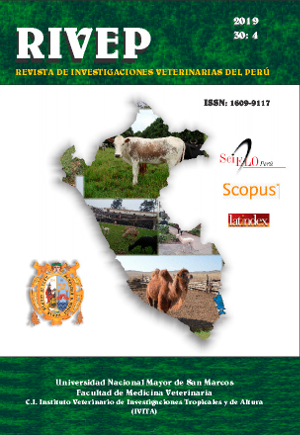Rabies in the Americas, various challenges and "One Health": Review article
DOI:
https://doi.org/10.15381/rivep.v30i4.17150Keywords:
rabies virus, viral variants, bats, rabies transmission, human rabiesAbstract
Rabies is caused by a neurotropic virus of negative RNA chain belonging to the genus Lyssavirus, family Rhabdoviridae, Mononegavirals order. The rabies-causing species in the Americas is the Lyssavirus RABV with 11 antigenic variants. Human rabies deaths have been drastically reduced in the United States over the past decade, yet cases of rabies are reported in dogs and cats infected by wild mammals. In Canada, as in the United States, the most common species of rabies reservoirs are wild mammals, mainly bats, skunks and foxes. Rabies is endemic in most of the Canadian Arctic, caused by the Arctic Rabies Virus variant. In North America, cross-species transmission has been observed. Wildlife control is carried out by oral bait vaccine, authorized in raccoons and coyotes. In Latin America and the Caribbean, canine rabies has declined by 98% and human rabies transmitted by dogs is in the way of elimination. In spite of this, Latin America faces a complex situation due to the re-emergence of canine rabies in areas declared free, emergence of human rabies transmitted by cats associated with variant 3 «Vampire», increase in wild rabies in cattle, and still a high incidence of human rabies transmitted by dogs in countries like Bolivia and Haiti. As these challenges involve people, animals and ecosystems, control strategies must be different from those applied to human rabies only. The One Health approach, which takes into account these three elements, and implies changes from the conducting an anti-rabies campaign, the way of analysing epidemiological and biomolecular data of the virus, will be essential in the search for zero human deaths, containment of wild rabies and regional elimination of canine and feline rabies.
Downloads
Downloads
Published
Issue
Section
License
Copyright (c) 2020 María del Pilar Sánchez, Rosa Angélica Sanmiguel, Oscar Alejandro Díaz Sanchez, Angie Alexandra Ramirez, Luis Escobar

This work is licensed under a Creative Commons Attribution-NonCommercial-ShareAlike 4.0 International License.
AUTHORS RETAIN THEIR RIGHTS:
a. Authors retain their trade mark rights and patent, and also on any process or procedure described in the article.
b. Authors retain their right to share, copy, distribute, perform and publicly communicate their article (eg, to place their article in an institutional repository or publish it in a book), with an acknowledgment of its initial publication in the Revista de Investigaciones Veterinarias del Perú (RIVEP).
c. Authors retain theirs right to make a subsequent publication of their work, to use the article or any part thereof (eg a compilation of his papers, lecture notes, thesis, or a book), always indicating the source of publication (the originator of the work, journal, volume, number and date).










